Selfbuilt's 100-Yard Outdoor Beamshots Roundup 2010 - now 49 lights!
This review has been replaced with a new comparison, sumarizing all my 2011 beamshots:
Selfbuilt's 100-Yard Outdoor Beamshot Compendium 2011
Please refer to that thread for all new images and commentary. This older thread will be left up for historical purposes (i.e. comparisons of older lights no longer available). :wave:
------------
UPDATES: As Jan 20, 2011, I have added five series of updated beamshots to this review, bringing the total number of unique lights to 49. Each additional series includes comparison shots of some of the previous lights. For animated GIFs showing key comparisons, please check out the individual reviews of the lights.
I generally leave it to others to post outside beamshots – simply because I have too much other work to do to get my reviews done! :sweat:
External beamshots are also tricky to do well – the shots will never match what you see by eye due to limitations of the camera (plus varying lighting conditions, topographical features, camera settings, etc.). Directly comparing lights is thus fraught with potential confounds that may invalidate the comparisons (especially for those shots taken at different times).
But due to popular demand – and with these caveats in mind - I've decided to do a limited run of 100-yard beamshots for a number of my lights. I may choose to update this round-up with additional lights in the future, but no guarantees!
It has taken me awhile to find what I consider to be a suitable location near where I live. Bear with me while I describe the location, so you can better interpret what you are seeing in the shots.
I've found a closed and deserted service road, located near a ravine. Here is an aerial view taken from Google maps:
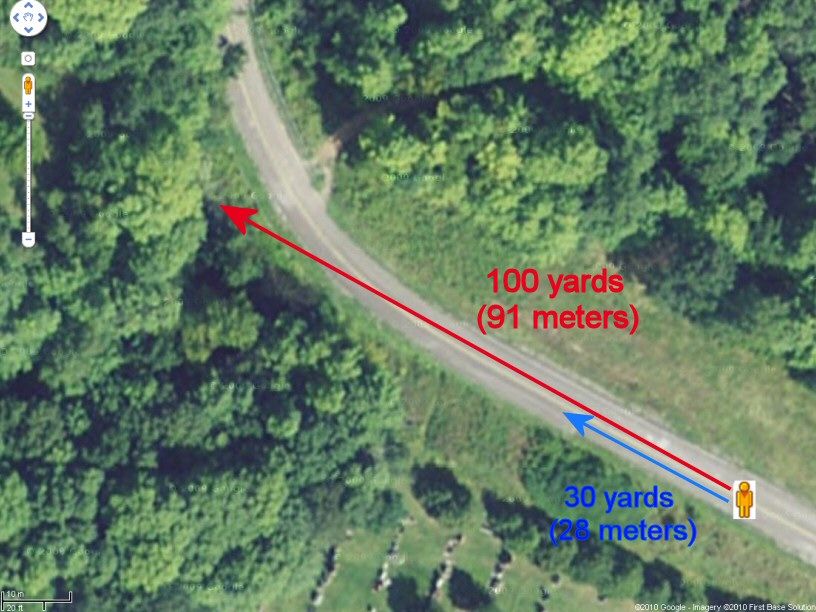
As you can see, there is a straight line from my position (pictogram) along the road, to a copse of tree located 100 yards away. There is a dead birch tree right at the red arrow-head that is a convenient marker for the photos.
I've also highlighted a point 30 yards from my position (blue arrow). The reason for this is shown on the side schematic for this area:
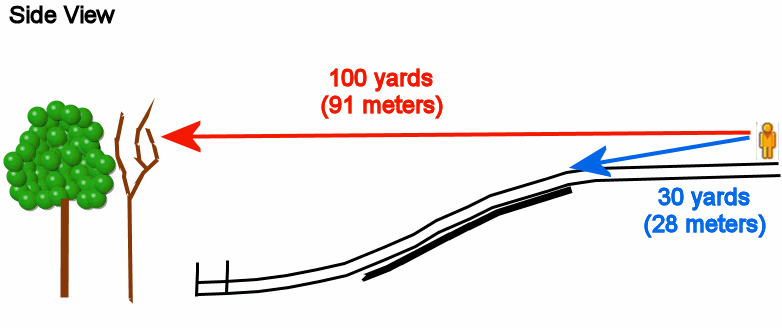
As I mentioned, this road goes along a ravine, and there is a significant elevation drop beginning about 30 yards along the road. The road makes a right turn as it winds down the ravine, but you can't tell from the indicated pictogram position – beyond 30 yards, all you see is the 100-yard trees in the distance. Here is a control shot in daylight to show you what I mean:
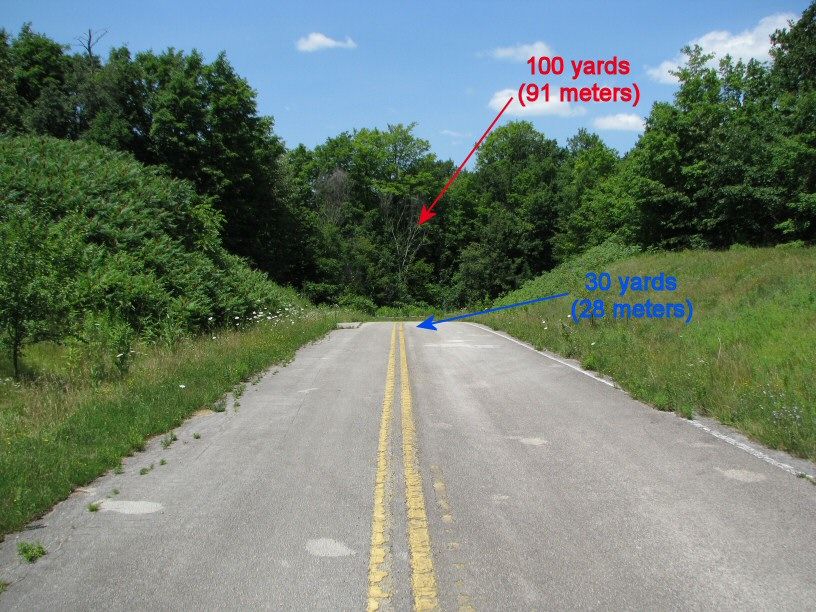
This shot is taken at eye level, and I have centered the camera on the copse of trees at 100 yards (specifically, right in the middle of the dead birch tree – red arrow). The blue arrow indicates the point at 30 yards beyond which the road "falls out of view."
For all flashlight pictures, I have angled the light directly above the camera, focused on the center of that dead birch tree. Because of the angle, this means that a good amount of the hotspot's corona should light up the road around that 30 yard mark. You will thus be able to see not only the center beam throw at 100 yards, but the corona spill at 30 yards, and the wider spillbeam in the foreground in front of the camera.
I didn't take a control shot in the dark, but here's the closest thing – a maximally focused Mag 3D incan on 3xD cell alkalines.
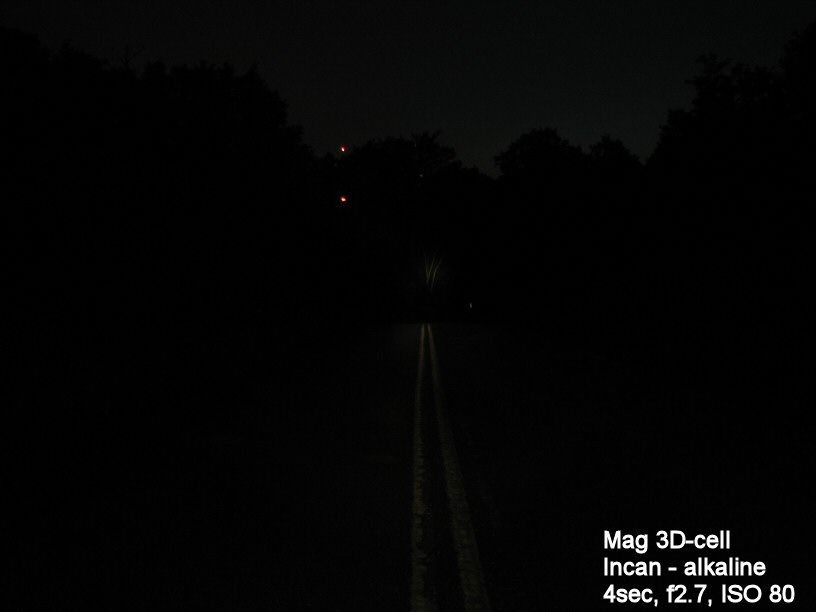
You can't see much because I've set the camera settings to what works well for the high-output LED shots (you may be able to faintly see the 100-yard away trees in the center of the beam, plus some of the road markings near the 30 yard mark).
Something else you will see are a couple of red dots in the background – these come from the aerial warning lights on a series of communication towers located in a clearing about 650 yards away (you can't see them in the daylight shot, they are too small and far away). There's also a photo-reflective sign along the bottom portion of the road that you may notice in some of the shots (left-over from when the road was in use, warning of the steep curve)
For the sake of this round-up, all lights were run on Max, on the highest rechargeable battery option the light would take.
The camera has been set to 4sec exposure, f2.7, ISO 80 and automatic white balance. This last point is to insure the incans and LEDs don't look exceedingly warm or cool - the goal here is to compare the beam profiles, not tints.
PLEASE NOTE: the pics typically look under-exposed relative to what I subjectively saw during shooting! Most of the lights could easily light up 100 yards, but it may not look that way in the pics (e.g. the Mag incan was at least serviceable, but you can't see much in the photos). Again, this is just the difficulty of finding a good exposure that shows you everything - it doesn't match what the eye sees. You also need to realize that your monitor and graphics card setup may look very different from mine - I know from experience that this can vary widely in terms of brightness and contrast. Again, the goal is only to provide relative throw comparison, not absolute representations of what I saw.
A COMMENT ON COMPARING THE IMAGES: To make this more manageable, I have reduced the images to 50% for this page – but each image is a link to a higher resolution scan. The best way to directly compare the lights is to open them in separate tabs. If this doesn't happen automatically when you click on them, right-click on an image, and choose "Open Link in a New Tab". Then repeat this process for a second light, and so on. This way, you will then be able to switch between your browser's tabs to see the matching higher resolution images taken at exactly the same position (i.e. the images should look stationary, with only the lighting conditions changing). You may need to zoom in, depending on your browser display settings :thumbsup:
And now for the main show ...
HID/Incan/SST-90 Lights:
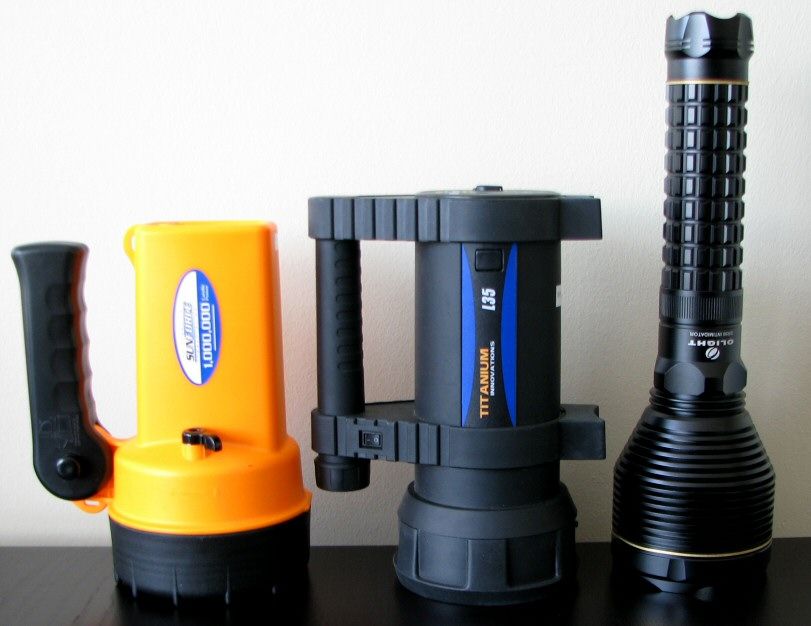
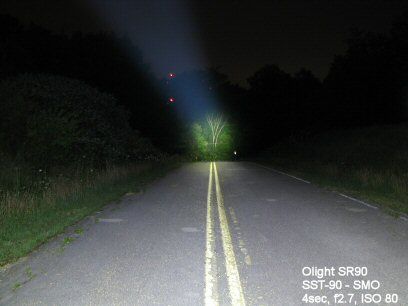
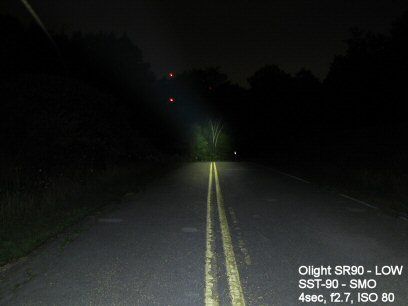
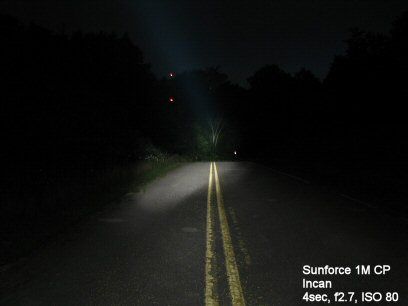
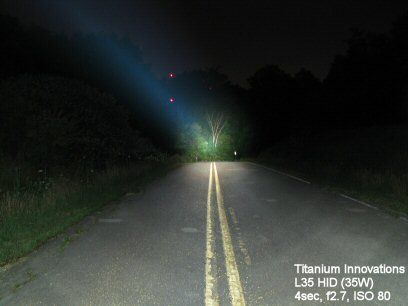
High-Output or Multi-Emitter – 2x18650 - Lights:
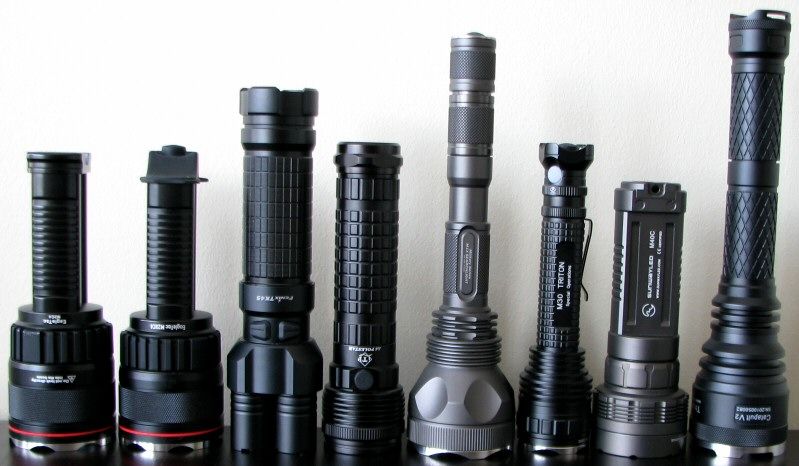
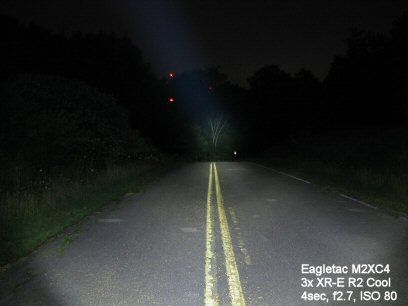
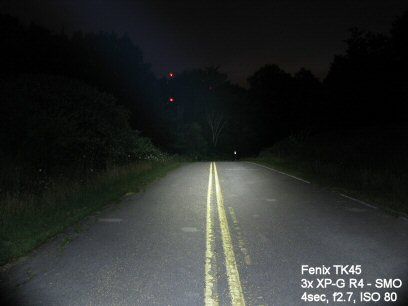
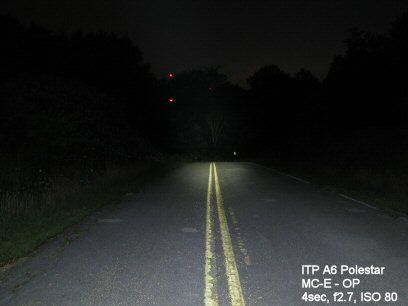
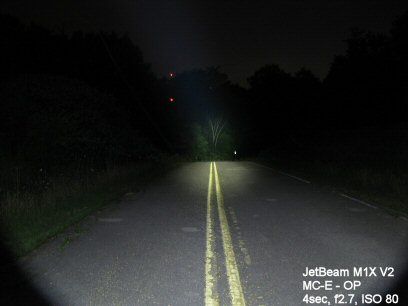
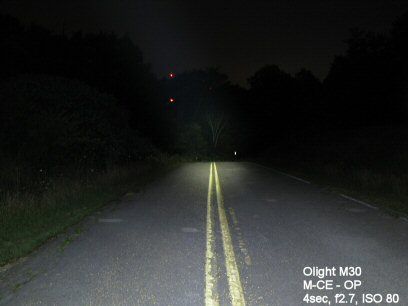
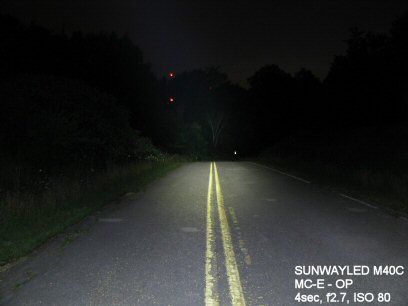
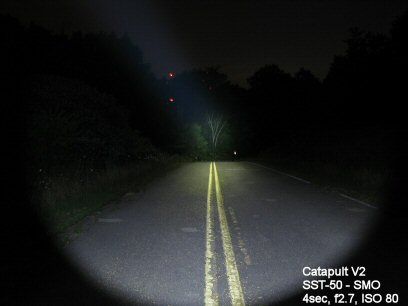
Second Batch – September 2010
I've retaken the Eagletac M2C4 & M2XC4, to allow you to directly compare to the new M3C4 series lights (M3C4 3x XP-G R5 Cool White, and M3C4 SST-50 Cool White). SUNWAYLED M40A also added, compared to the M40C.
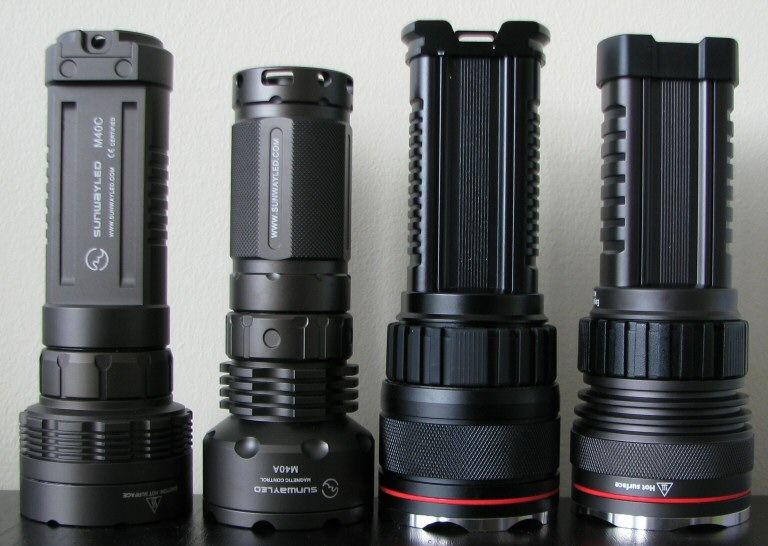
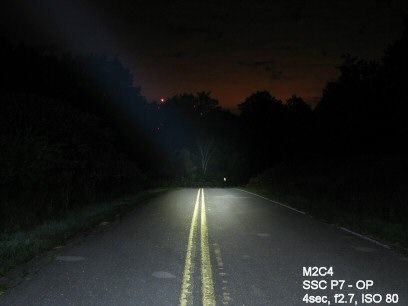
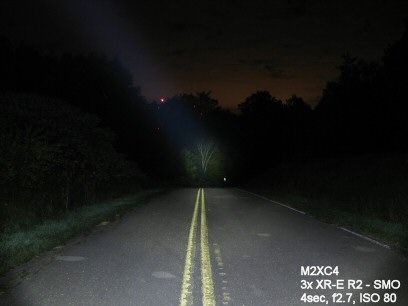
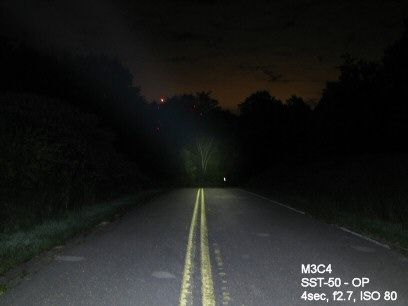
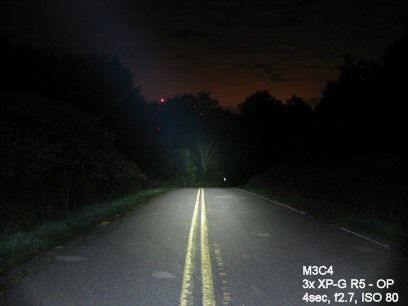
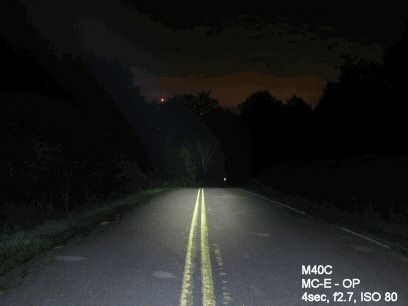
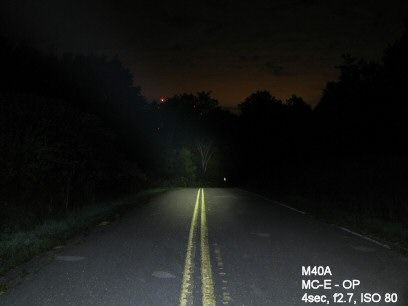
Third Batch – November 2010
I've added to this class of the round-up the new Eagletac M3C4 SST-50 (revised Deep-SMO reflector), Olight M31 (SST-50), SUNWAYMAN M60R (SST-50). Note that the time of year means that there is little foliage on the trees now, so more of those transmission tower red lights are showing up!
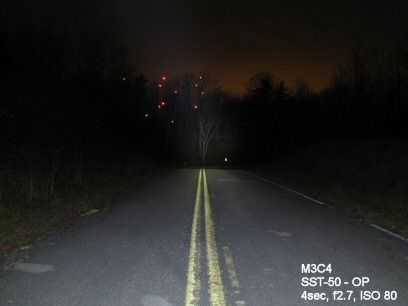
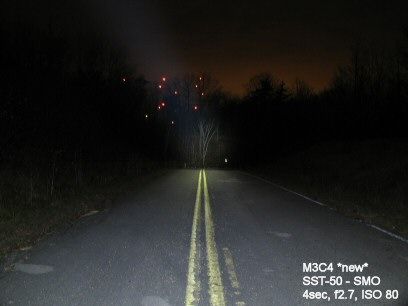
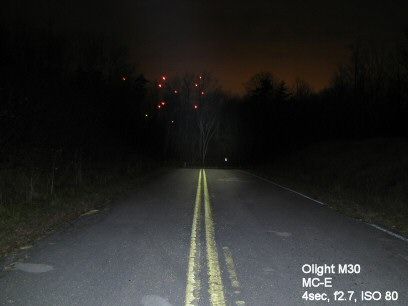
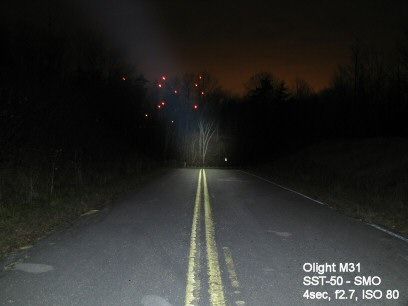
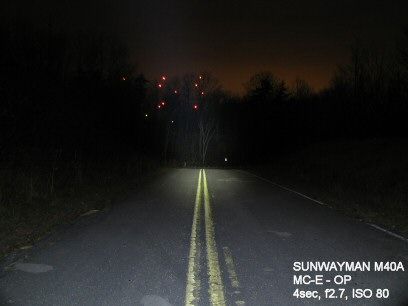
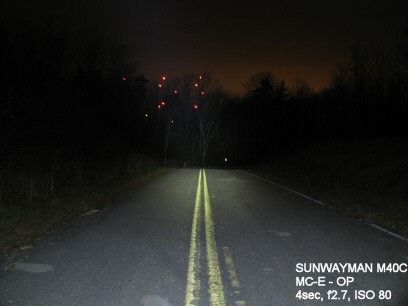
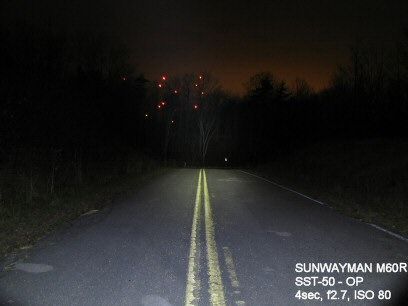
Fourth Batch – December 2010
I've added to this class of the round-up the Catapult V2 XM-L (Cree XM-L) and Eagletac M3C4 XM-L (Cree XM-L). Those "streaks" you may notice in the foreground of the beam paths are from a light snowfall that was blowing through the exposures.
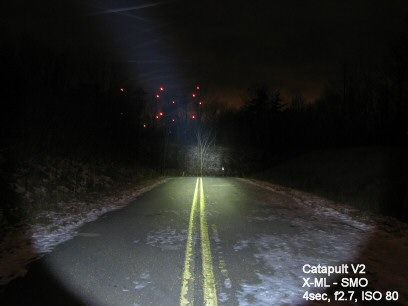

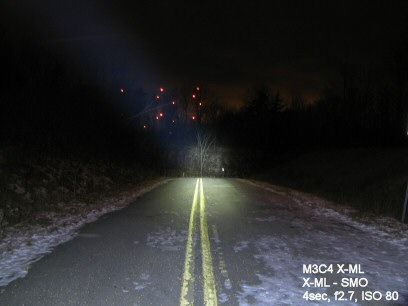
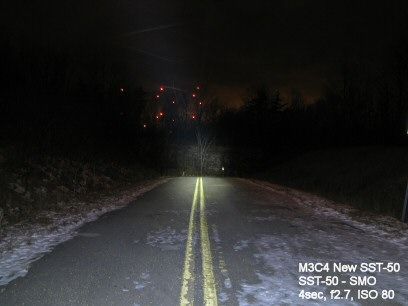
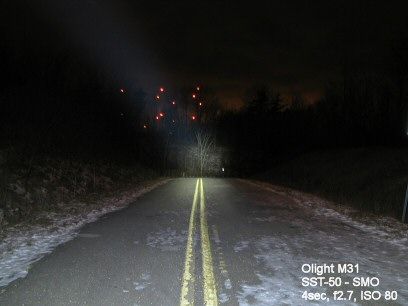
Fifth Batch – January 2011
I've added to this class of the round-up the Lumintop TD15X. Note that the snowfall combined with moonlight and nearby city lights causes a lot of ambient light reflection (i.e. background brightness is much higher than on other comparisons). The snow also causes a lot more diffusion of the hotspots and spillbeams, again due to reflections.
For the TD15X, "2X" refers to 2x18650 (with two extender tubes), and "1X" refers 1x18650. All lights on Max.
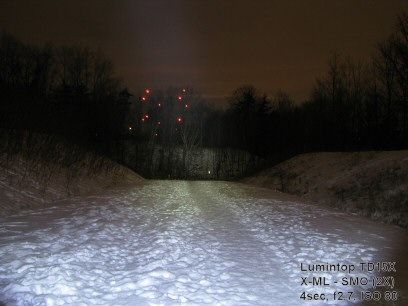
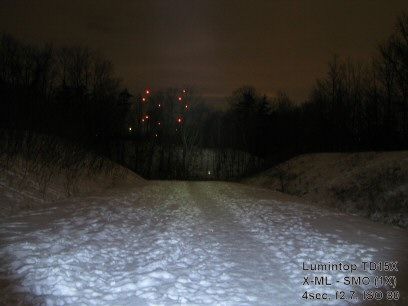
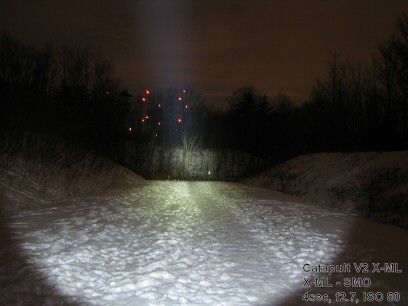
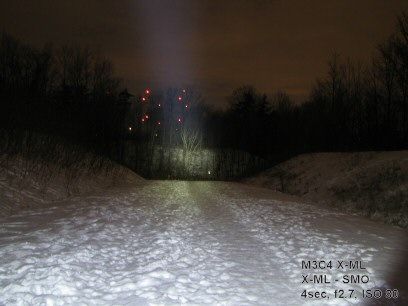
Single Emitter – 2xRCR – Lights:
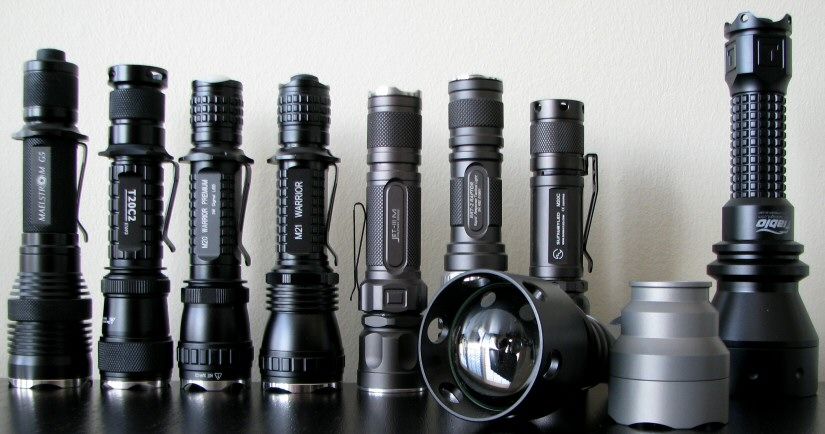
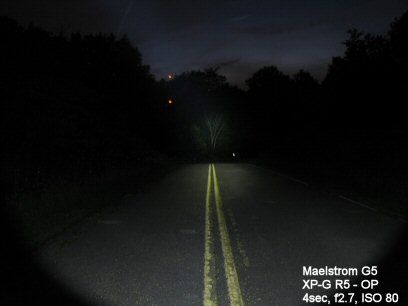
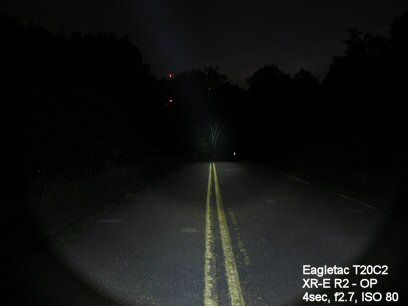
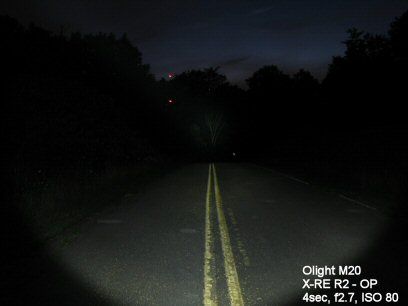
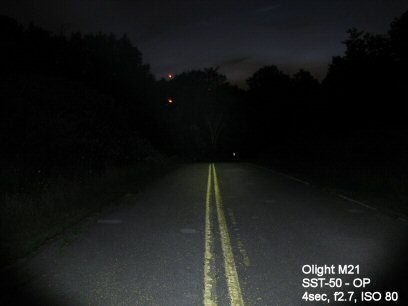
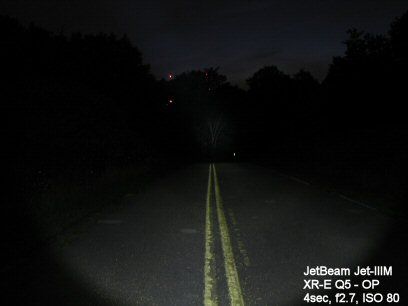
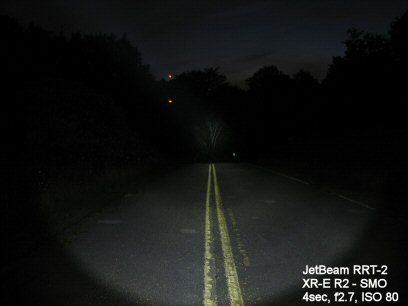
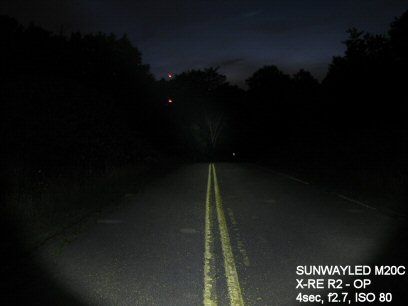
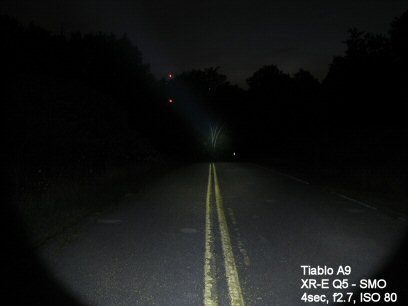
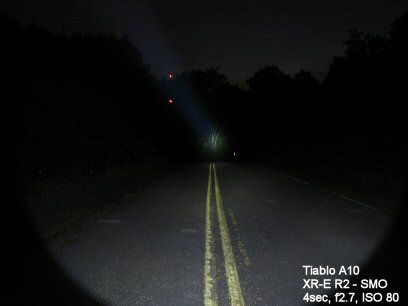
Second Batch – September 2010
I've retaken the Tiablo A9-Q5 & A10 shots, to compare to the new A9-R5 (also added the DBS R2 for comparison). Aspheric head shots included for both A9 versions. I've also retaken the 4Sevens Maelstrom G5 now that the shipping sample has arrived. Other lights added include the Eagletac T20C2-II R5, Fenix TK12.
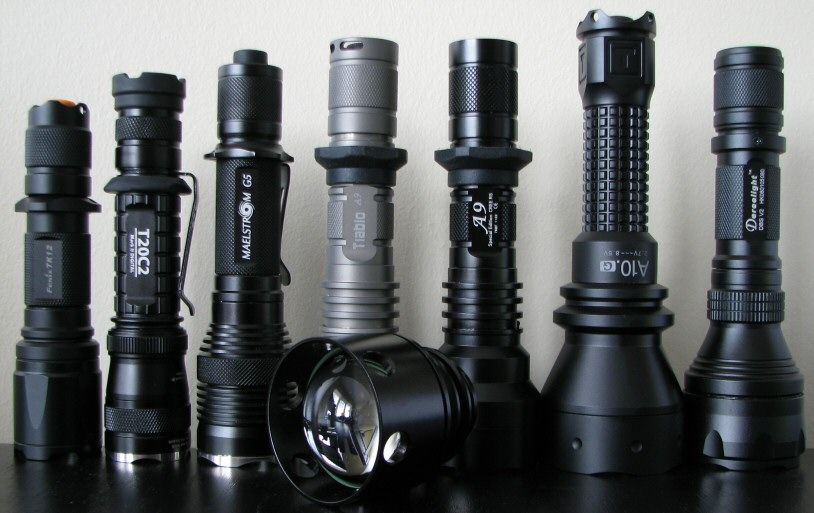
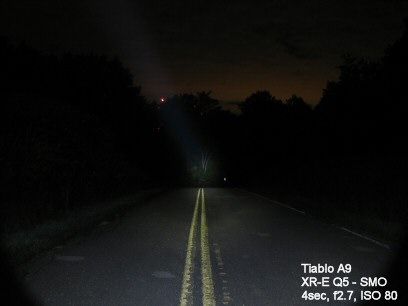
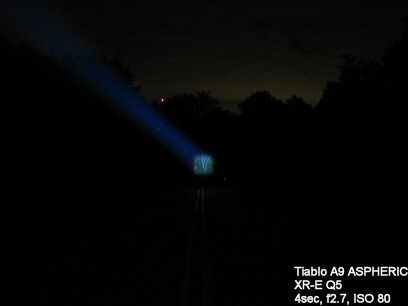
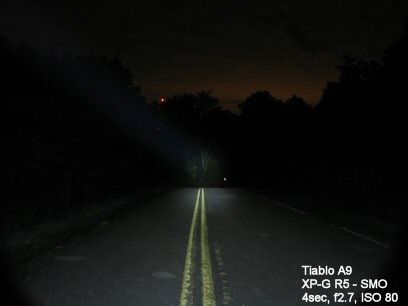

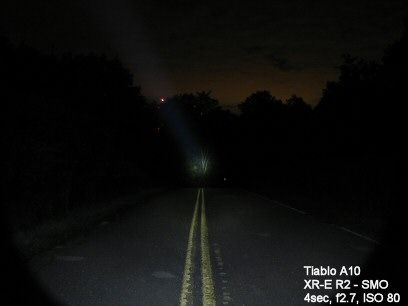

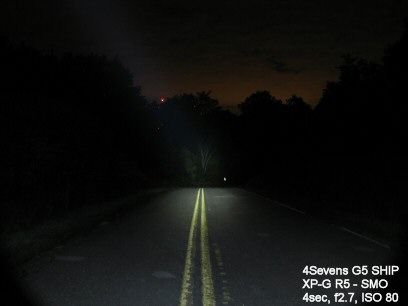
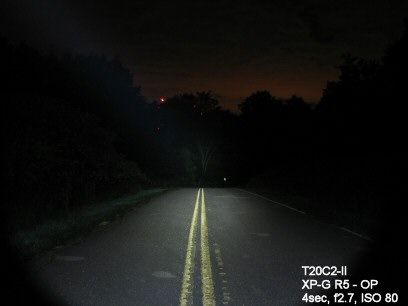
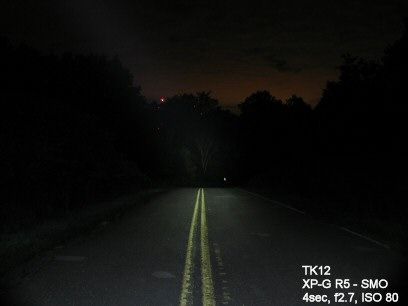
Third Batch – November 2010
I've added to this class of the round-up the Jian Wei W1 (XR-E R2), Ray Tactical X60 (XP-G R5) and Lumintop TD-15 (XP-G R5). Note that the time of year means that there is little foliage on the trees now, so more of those transmission tower red lights are showing up!
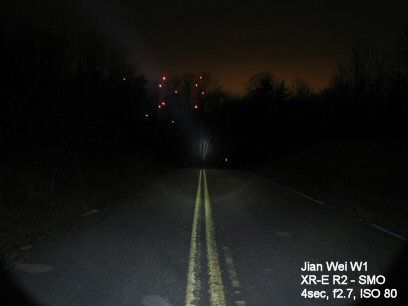
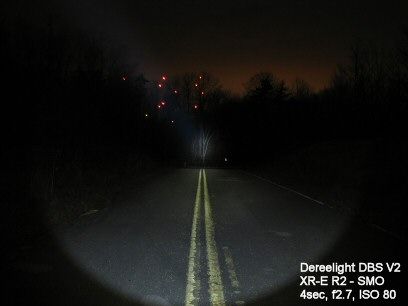
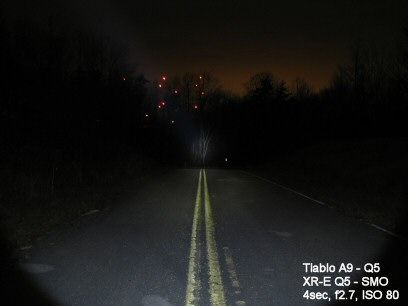
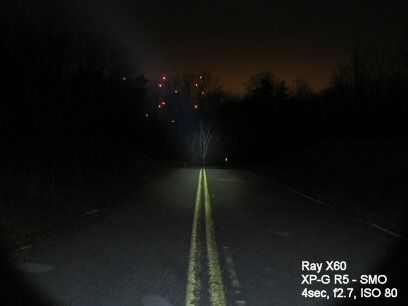
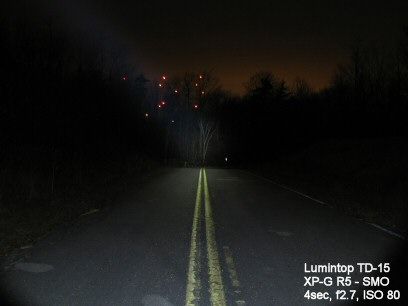
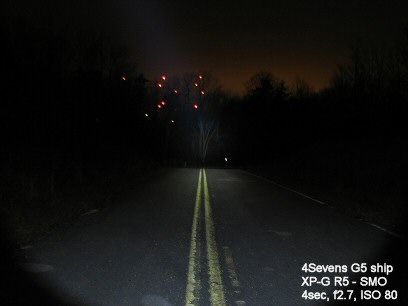
Fourth Batch – December 2010
I've added to this class of the round-up the ArmyTek Predator (XP-G R5) and ITP R01 (XP-E Q5).
Note that I wasn't entirely consistent in my aiming of the lights, so please take that into account when comparing the hotspots and coronas.

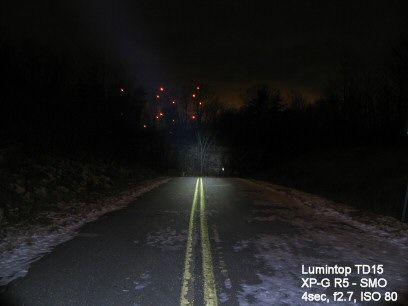
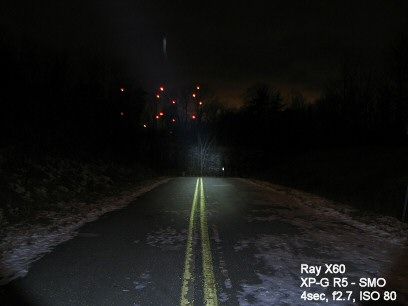
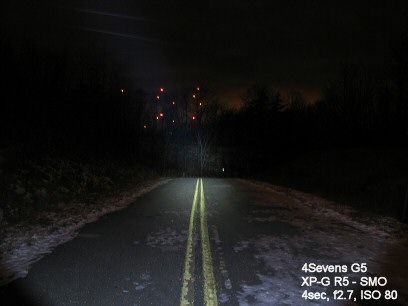
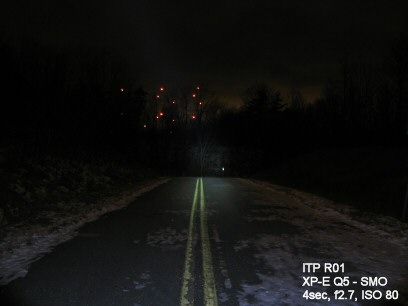
Fifth Batch – January 2011
I've added to this class of the round-up the Xtar D01 (XP-G R5), and a replacement ArmyTek Predator (XP-G R5). Note that the snowfall combined with moonlight and nearby city lights causes a lot of ambient light reflection (i.e. background brightness is much higher than on other comparisons). The snow also causes a lot more diffusion of the hotspots and spillbeams, again due to reflections.
Note that I wasn't entirely consistent in my aiming of the lights, so please take that into account when comparing the hotspots and coronas.
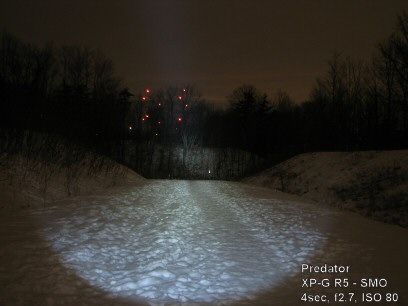
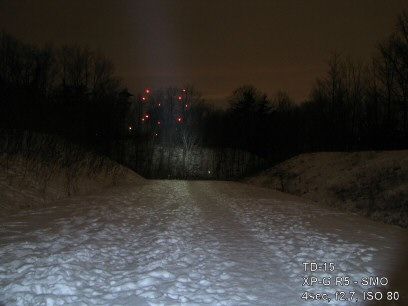
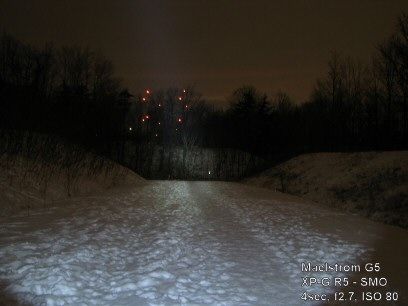
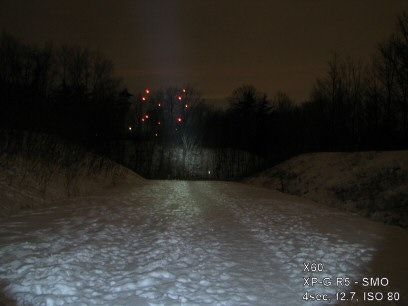
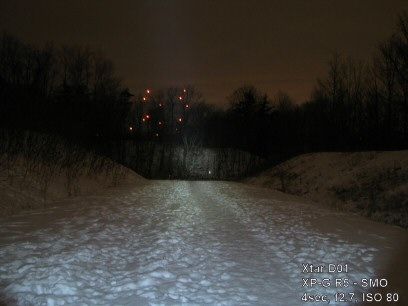

Single Emitter – 1xRCR – Lights:
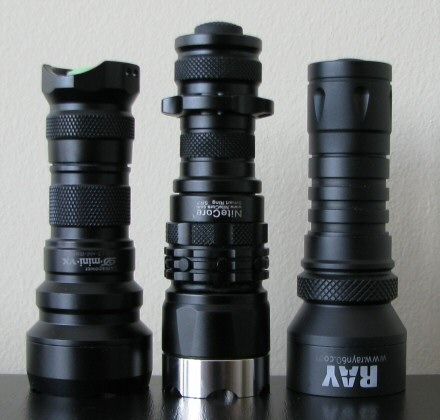
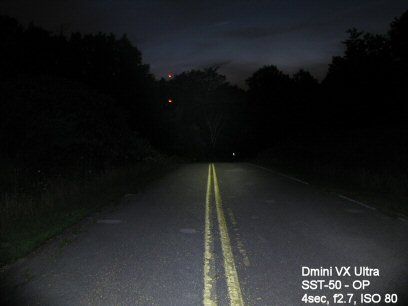
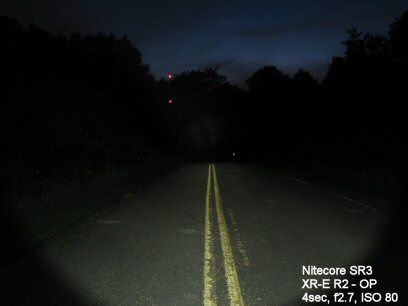
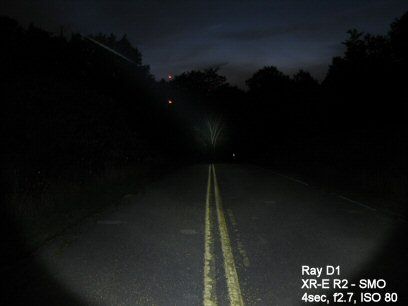
Again, as with all beamshot comparisons, some of the pics can be misleading.
I will be posting animated GIFs of the full resolution pics in some of my recent reviews, to show the most relevant comparisons.
:wave:
This review has been replaced with a new comparison, sumarizing all my 2011 beamshots:
Selfbuilt's 100-Yard Outdoor Beamshot Compendium 2011
Please refer to that thread for all new images and commentary. This older thread will be left up for historical purposes (i.e. comparisons of older lights no longer available). :wave:
------------
UPDATES: As Jan 20, 2011, I have added five series of updated beamshots to this review, bringing the total number of unique lights to 49. Each additional series includes comparison shots of some of the previous lights. For animated GIFs showing key comparisons, please check out the individual reviews of the lights.
I generally leave it to others to post outside beamshots – simply because I have too much other work to do to get my reviews done! :sweat:
External beamshots are also tricky to do well – the shots will never match what you see by eye due to limitations of the camera (plus varying lighting conditions, topographical features, camera settings, etc.). Directly comparing lights is thus fraught with potential confounds that may invalidate the comparisons (especially for those shots taken at different times).
But due to popular demand – and with these caveats in mind - I've decided to do a limited run of 100-yard beamshots for a number of my lights. I may choose to update this round-up with additional lights in the future, but no guarantees!
It has taken me awhile to find what I consider to be a suitable location near where I live. Bear with me while I describe the location, so you can better interpret what you are seeing in the shots.
I've found a closed and deserted service road, located near a ravine. Here is an aerial view taken from Google maps:

As you can see, there is a straight line from my position (pictogram) along the road, to a copse of tree located 100 yards away. There is a dead birch tree right at the red arrow-head that is a convenient marker for the photos.
I've also highlighted a point 30 yards from my position (blue arrow). The reason for this is shown on the side schematic for this area:

As I mentioned, this road goes along a ravine, and there is a significant elevation drop beginning about 30 yards along the road. The road makes a right turn as it winds down the ravine, but you can't tell from the indicated pictogram position – beyond 30 yards, all you see is the 100-yard trees in the distance. Here is a control shot in daylight to show you what I mean:

This shot is taken at eye level, and I have centered the camera on the copse of trees at 100 yards (specifically, right in the middle of the dead birch tree – red arrow). The blue arrow indicates the point at 30 yards beyond which the road "falls out of view."
For all flashlight pictures, I have angled the light directly above the camera, focused on the center of that dead birch tree. Because of the angle, this means that a good amount of the hotspot's corona should light up the road around that 30 yard mark. You will thus be able to see not only the center beam throw at 100 yards, but the corona spill at 30 yards, and the wider spillbeam in the foreground in front of the camera.
I didn't take a control shot in the dark, but here's the closest thing – a maximally focused Mag 3D incan on 3xD cell alkalines.

You can't see much because I've set the camera settings to what works well for the high-output LED shots (you may be able to faintly see the 100-yard away trees in the center of the beam, plus some of the road markings near the 30 yard mark).
Something else you will see are a couple of red dots in the background – these come from the aerial warning lights on a series of communication towers located in a clearing about 650 yards away (you can't see them in the daylight shot, they are too small and far away). There's also a photo-reflective sign along the bottom portion of the road that you may notice in some of the shots (left-over from when the road was in use, warning of the steep curve)
For the sake of this round-up, all lights were run on Max, on the highest rechargeable battery option the light would take.
The camera has been set to 4sec exposure, f2.7, ISO 80 and automatic white balance. This last point is to insure the incans and LEDs don't look exceedingly warm or cool - the goal here is to compare the beam profiles, not tints.
PLEASE NOTE: the pics typically look under-exposed relative to what I subjectively saw during shooting! Most of the lights could easily light up 100 yards, but it may not look that way in the pics (e.g. the Mag incan was at least serviceable, but you can't see much in the photos). Again, this is just the difficulty of finding a good exposure that shows you everything - it doesn't match what the eye sees. You also need to realize that your monitor and graphics card setup may look very different from mine - I know from experience that this can vary widely in terms of brightness and contrast. Again, the goal is only to provide relative throw comparison, not absolute representations of what I saw.
A COMMENT ON COMPARING THE IMAGES: To make this more manageable, I have reduced the images to 50% for this page – but each image is a link to a higher resolution scan. The best way to directly compare the lights is to open them in separate tabs. If this doesn't happen automatically when you click on them, right-click on an image, and choose "Open Link in a New Tab". Then repeat this process for a second light, and so on. This way, you will then be able to switch between your browser's tabs to see the matching higher resolution images taken at exactly the same position (i.e. the images should look stationary, with only the lighting conditions changing). You may need to zoom in, depending on your browser display settings :thumbsup:
And now for the main show ...

HID/Incan/SST-90 Lights:





High-Output or Multi-Emitter – 2x18650 - Lights:








Second Batch – September 2010
I've retaken the Eagletac M2C4 & M2XC4, to allow you to directly compare to the new M3C4 series lights (M3C4 3x XP-G R5 Cool White, and M3C4 SST-50 Cool White). SUNWAYLED M40A also added, compared to the M40C.







Third Batch – November 2010
I've added to this class of the round-up the new Eagletac M3C4 SST-50 (revised Deep-SMO reflector), Olight M31 (SST-50), SUNWAYMAN M60R (SST-50). Note that the time of year means that there is little foliage on the trees now, so more of those transmission tower red lights are showing up!







Fourth Batch – December 2010
I've added to this class of the round-up the Catapult V2 XM-L (Cree XM-L) and Eagletac M3C4 XM-L (Cree XM-L). Those "streaks" you may notice in the foreground of the beam paths are from a light snowfall that was blowing through the exposures.






Fifth Batch – January 2011
I've added to this class of the round-up the Lumintop TD15X. Note that the snowfall combined with moonlight and nearby city lights causes a lot of ambient light reflection (i.e. background brightness is much higher than on other comparisons). The snow also causes a lot more diffusion of the hotspots and spillbeams, again due to reflections.
For the TD15X, "2X" refers to 2x18650 (with two extender tubes), and "1X" refers 1x18650. All lights on Max.




Single Emitter – 2xRCR – Lights:










Second Batch – September 2010
I've retaken the Tiablo A9-Q5 & A10 shots, to compare to the new A9-R5 (also added the DBS R2 for comparison). Aspheric head shots included for both A9 versions. I've also retaken the 4Sevens Maelstrom G5 now that the shipping sample has arrived. Other lights added include the Eagletac T20C2-II R5, Fenix TK12.










Third Batch – November 2010
I've added to this class of the round-up the Jian Wei W1 (XR-E R2), Ray Tactical X60 (XP-G R5) and Lumintop TD-15 (XP-G R5). Note that the time of year means that there is little foliage on the trees now, so more of those transmission tower red lights are showing up!






Fourth Batch – December 2010
I've added to this class of the round-up the ArmyTek Predator (XP-G R5) and ITP R01 (XP-E Q5).
Note that I wasn't entirely consistent in my aiming of the lights, so please take that into account when comparing the hotspots and coronas.





Fifth Batch – January 2011
I've added to this class of the round-up the Xtar D01 (XP-G R5), and a replacement ArmyTek Predator (XP-G R5). Note that the snowfall combined with moonlight and nearby city lights causes a lot of ambient light reflection (i.e. background brightness is much higher than on other comparisons). The snow also causes a lot more diffusion of the hotspots and spillbeams, again due to reflections.
Note that I wasn't entirely consistent in my aiming of the lights, so please take that into account when comparing the hotspots and coronas.






Single Emitter – 1xRCR – Lights:




Again, as with all beamshot comparisons, some of the pics can be misleading.
I will be posting animated GIFs of the full resolution pics in some of my recent reviews, to show the most relevant comparisons.
:wave:
Last edited:

